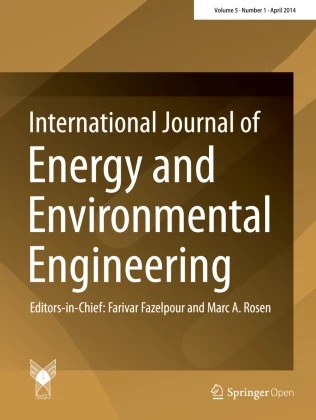The effective combination of zirconia superacid and zirconia-impregnated CaO in biodiesel manufacturing: Utilization of used coconut cooking oil (UCCO)
- Department of Chemistry, Faculty of Mathematics and Natural Science, Universitas Gadjah Mada, Yogyakarta, ID Research Center for Accelerator Technology, Research Organization for Nuclear Technology - National Research and Innovation Agency (BATAN-BRIN), Yogyakarta, 55281, ID
- Department of Chemistry, Faculty of Mathematics and Natural Science, Universitas Gadjah Mada, Yogyakarta, ID
- Department of Chemistry, Biofuel Research Group, Faculty of Mathematics and Natural Science, Universitas Sriwijaya, Inderalaya, 30662, ID
- Research Center for Physics, National Research and Innovation Agency (BRIN), PUSPIPTEK, South Tangerang City, 15314, ID

Published in Issue 2021-10-23
How to Cite
Sari, E. P., Wijaya, K., Trisunaryanti, W., Syoufian, A., Hasanudin, H., & Saputri, W. D. (2021). The effective combination of zirconia superacid and zirconia-impregnated CaO in biodiesel manufacturing: Utilization of used coconut cooking oil (UCCO). International Journal of Energy and Environmental Engineering, 13(3 (September 2022). https://doi.org/10.1007/s40095-021-00439-4
Abstract
Abstract The present study reports the effective combination of zirconia superacid and zirconia-impregnated CaO in biodiesel manufacturing through the utilization of used coconut cooking oil. The acid catalyst was synthesized by the wet impregnation method combined with H 2 SO 4 0.9 M. This mixture was calcined at 500 °C and yielding the highest catalyst acidity of 3.60 mmol g −1 . The free fatty acid (FFA) levels of UCCO then was reduced through the esterification process by varying the catalyst weight, UCCO-to-methanol mole ratio, calcination temperature, and reaction time. Optimum FFA level was achieved with 5% catalyst weight, 1:15 UCCO/methanol ratio, and 1.5 h reaction time with reduced FFA level to 0.42%. The Zr–CaO catalyst was synthesized using the reflux method through heating at 80 °C for 4 h, achieving the highest catalyst basicity, 27.78 mmol g −1 , at a condition of 1% ( w / w ) Zr–CaO and calcination temperature of 800 °C. This catalyst was then used in the transesterification reaction to produce biodiesel. Transesterification reaction was carried out by 5% catalyst weight and esterification product to methanol mole ratio of 1:20 for 1.5 h, yielding a conversion value of UCCO into biodiesel of 55.35%.Keywords
- Biodiesel,
- Esterification,
- Transesterification,
- Acid–base catalyst,
- Used coconut cooking oil
References
- Kaur and Ali (2014) Kinetics and reusability of Zr/CaO as heterogeneous catalyst for the ethanolysis and methanolysis of Jatropha crucas oil (pp. 173-184) https://doi.org/10.1016/j.fuproc.2013.11.002
- Sibarani et al. (2010) Effect of Palm Empty Bunch Ash on Transesterification of Palm Oil Into Biodiesel 7(3) (pp. 314-319) https://doi.org/10.22146/ijc.21675
- Banković-Ilić et al. (2017) Application of nano CaO–based catalysts in biodiesel synthesis (pp. 746-760) https://doi.org/10.1016/j.rser.2017.01.076
- Patel et al. (2013) Biodiesel production by esterification of free fatty acid over sulfated zirconia (pp. 227-233) https://doi.org/10.1016/j.renene.2012.09.040
- Pratama et al. (2010) Effect of temperature and speed of stirrer to biodiesel conversion from coconut oil with the use of palm empty fruit bunches as a heterogeneous catalyst 9(1) (pp. 54-61) https://doi.org/10.22146/ijc.21562
- Binti Mohd Alias et al. (2019) Effect of free fatty acid pretreatment to yield, composition and activation energy in chemical synthesis of fatty acid methyl ester 19(3) (pp. 592-598) https://doi.org/10.22146/ijc.34492
- Marchetti et al. (2008) Techno-economic study of different alternatives for biodiesel production 89(8) (pp. 740-748) https://doi.org/10.1016/j.fuproc.2008.01.007
- Jacobson et al. (2008) Solid acid catalyzed biodiesel production from waste cooking oil 85(1–2) (pp. 86-91) https://doi.org/10.1016/j.apcatb.2008.07.005
- Fraenkel et al. (2010) Acid strength of solids probed by catalytic isobutane conversion 274(1) (pp. 29-51) https://doi.org/10.1016/j.jcat.2010.06.002
- Molaei Dehkordi and Ghasemi (2012) Transesterification of waste cooking oil to biodiesel using Ca and Zr mixed oxides as heterogeneous base catalysts (pp. 45-51) https://doi.org/10.1016/j.fuproc.2012.01.010
- Tian et al. (2010) Synthesis of crystalline ordered mesoporous CaO-ZrO2 solid solution as a promising solid base 124(1) (pp. 744-747) https://doi.org/10.1016/j.matchemphys.2010.07.050
- Wan Omar and Saidina Amin (2011) Optimization of heterogeneous biodiesel production from waste cooking palm oil via response surface methodology 35(3) (pp. 1329-1338) https://doi.org/10.1016/j.biombioe.2010.12.049
- Knothe (2000) Monitoring a progressing transesterification reaction by fiber-optic near infrared spectroscopy with correlation to 1H nuclear magnetic resonance spectroscopy 77(5) (pp. 489-493) https://doi.org/10.1007/s11746-000-0078-5
- Ardizzone et al. (2004) Liquid-phase catalytic activity of sulfated zirconia from sol-gel precursors: The role of the surface features 227(2) (pp. 470-478) https://doi.org/10.1016/j.jcat.2004.07.030
- Kuwahara et al. (2014) Esterification of levulinic acid with ethanol over sulfated mesoporouszirconosilicates: Influences of the preparation conditions on the structural properties and catalytic performances (pp. 18-28) https://doi.org/10.1016/j.cattod.2013.11.008
- Hauli et al. (2018) Preparation and characterization of sulfated zirconia from a commercial zirconia nanopowder 34(3) (pp. 1559-1564) https://doi.org/10.13005/ojc/340348
- Rachmat et al. (2017) Synthesis and characterization of sulfated zirconia mesopore and its application on lauric acid esterification 6(3) (pp. 1-9) https://doi.org/10.1007/s40243-017-0097-1
- Li et al. (2009) MgCoAl-LDH derived heterogeneous catalysts for the ethanol transesterification of canola oil to biodiesel 88(1–2) (pp. 42-49) https://doi.org/10.1016/j.apcatb.2008.09.022
- Takase (2014) Application of zirconia modified with KOH as heterogeneous solid base catalyst to new non-edible oil for biodiesel (pp. 117-125) https://doi.org/10.1016/j.enconman.2014.01.034
- Utami et al. (2017) Effect of sulfuric acid treatment and calcination on commercial zirconia nanopowder (pp. 131-137) https://doi.org/10.4028/www.scientific.net/KEM.757.131
- Petchmala (2010) Transesterification of palm oil and esterification of palm fatty acid in near- and super-critical methanol with SO4-ZrO2 catalysts 89(9) (pp. 2387-2392) https://doi.org/10.1016/j.fuel.2010.04.010
- Essamlali et al. (2017) Sodium modified hydroxyapatite: Highly efficient and stable solid-base catalyst for biodiesel production (pp. 355-367) https://doi.org/10.1016/j.enconman.2017.07.028
- Zhang et al. (2013) Heterogeneous CaO-ZrO2 acid-base bifunctional catalysts for vapor-phase selective dehydration of 1,4-butanediol to 3-buten-1-ol (pp. 233-239) https://doi.org/10.1016/j.apcata.2013.06.020
- Xia et al. (2014) Biodiesel synthesis over the CaO-ZrO2 solid base catalyst prepared by a urea-nitrate combustion method 4(93) (pp. 51688-51695) https://doi.org/10.1039/c4ra11362d
- Anantapinitwatna et al. (2019) Effect of Water Content in Waste Cooking Oil on Biodiesel Production via Ester-transesterification in a Single Reactive Distillation 559(1) https://doi.org/10.1088/1757-899X/559/1/012014
- Shah et al. (2014) Optimization Studies and Chemical Kinetics of Silica Sulfuric Acid-Catalyzed Biodiesel Synthesis from Waste Cooking Oil 7(1) (pp. 206-216) https://doi.org/10.1007/s12155-013-9363-y
- dos Santos (2019) Ethyl esters obtained from pequi and macaúba oils by transesterification with homogeneous acid catalysis 259(April) https://doi.org/10.1016/j.fuel.2019.116206

 10.1007/s40095-021-00439-4
10.1007/s40095-021-00439-4











